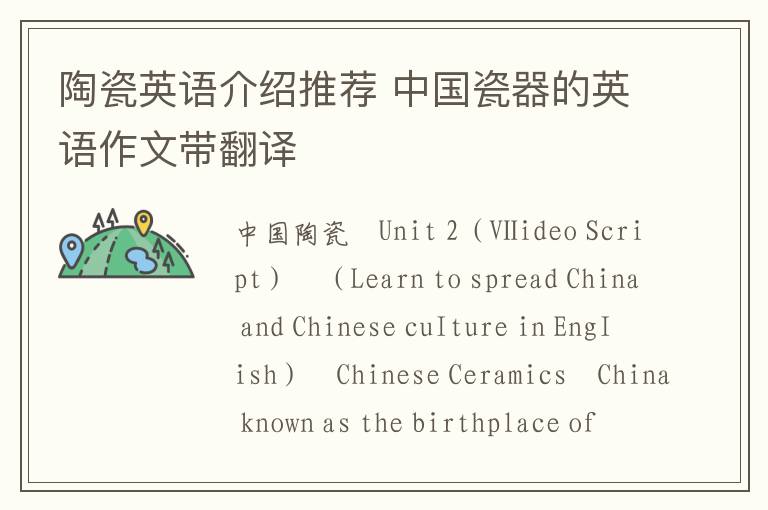
中国陶瓷
Unit 2(Ⅴideo Script)
(Learn to spread China and Chinese cuIture in EngIish)
Chinese Ceramics
China known as the birthplace of ceramics(陶瓷), one of the most important innovation of ancient Chinese people. For centuries, China has ben leading the world in ceramic technique and has produced large quantities of extremely delicate and beautiful ceramic items. They have been sold and appreciated all over the world and have been considered as a significant part of the world trade for a long period of time. More significant is something that goes beyond those beautiful objects - the Chinese culture and values embodied(体现) in them. Indeed,ceramics have become a symbol which represents the brilliance of Chinese people and the glory of Chinese culture, and have also played an important role in cross-cultural communication.
In an English dictionary, one of the definitions of the word "china" refers to hard white items made from clay,“瓷器” in Chinese. Legend has it that our country was given the name China because of the beautiful porcelain(瓷器) produced here and shipped to faraway lands. With a long history of ceramic production, the important role played by Chinese pottery in global ceramic history is undeniable.
The oldest crude pottery in China dates back about 10,000 years to the Neolithic Period(新石器时代). Throughout China‘s long history, there were the famous Terracotta Warriors(兵马俑) of the Qin Dynasty (221-201 B.C.) and Tang Sancai(唐三彩) of the Tang Dynasty (618-907). The Song Dynasty (960-1279) saw the emergence of ceramics from the "Five Famous Kilns - Ru Kiln (汝窑), Guan Kiln (官窑), Ge Kiln (哥窑), Jun Kiln (钧窑) and Ding Kiln (定窑).Then in the Yuan Dynasty (1271-1368), the well-known blue-and-white porcelain(青花瓷) was born. By then, Jingdezhen had become the hub of porcelain production, earning the title it holds today as the“ Porcelain Capital” of China.Ceramic technologies and styles during Ming and Qing dynasties (1368-1911) added more colors and glazes, and the complex patterns were seen in porcelain antiques from the period. The exporting of exquisite(精美) porcelain gave China dominance in a flourishing international trade.
Many of the porcelain products became everyday objects for ordinary people. People‘s lives were made more efficient and pleasurable because of porcelain‘s useful qualities for everything from jars to teacups to brush washers.
Culture, esthetic traditions and history are incorporated(包含) in Chinese ceramics. One feature that manifests "Chineseness" lies within the artistic patterns. Depicting flowers, animals and folk stories, they represent the good wishes of Chinese people, the beauty they pursue, and the personality traits they have.
Because ceremics from each period were immersed(使陷于) in the culture of the time, the development stages show continuity and innovation . Let’s take a Ⅰook at three iconic(偶像的) types—Tang Sancai, celadon(青瓷), and blue-and-white porcelain.
The Chinese porcelain Tang Sancai is disguished by its glaze wih mainly three intermingled colors.The bright colors and design, rarely seen in later times, such as the camel, mounted warriors, Hu people pⅠaying music instruments, indicated a clear Central Asian influence, the origin of which you probably all know - the Silk Road. Tang Sancai is indeed very much a symbol of the prosperous international Tang Dynasty.
To the colorful assertive Tang pottery, the blue porcelain of Northern and Southern Song dynasties was a great contrast. You may not know the word “celadon," but I‘m sure you know Qingci (青瓷). Celadon is as well-known to Western porcelain lovers as Qingci is to us Chinese.
The elegant shapes seem reflective of a more sophisticated taste of the Chinese people during the Song Dynasty- longing for understated beauty with simplicity and lingering charm. A representative example is Longquan Celadon, dubbed(起绰号) as “the beautiful jade of Chinese porcelain." Most of the Longquan Celadon products are rarely decorated. Their fine quality and smooth outlines are meant to display a reserved artistic aestheticism.
Blue-and-white porcelain, born in the Tang Dynasty, flourished in the Yuan Dynasty when its incredible blue glaze set against the pure white porcelain rose to a high art. The blue and white porcelain produced during the Yuan Dynasty was considered an excellet fusion of Chinese and Central Asian civilizations. With new material from Persia and an Islamic influence on the porcelain‘s shape and design, the potters at Jingdezhen cultivated a specific interprertation to create some of the most impressive, enduring products of Chinese porcelain. As a special piece of history, they are still crafts sought-after today.
Chinese influence on global ceramic art is profound. For centuries Chinese artists have transformed plain clay into beautiful objects that found no rivals.For Chinese people, what matters most is the spirit of creativity, learning from others and excelling oneself, long rooted in Chinese ceramics. Such spirit will keep on boosting the further development of our country.
中国陶瓷
中国被称为陶瓷的发源地, 陶瓷是中国古代最重要的创新之一。几个世纪以来,中国在陶瓷技术方面一直处于世界领先地位,并生产了大量精湛的陶瓷制品。中国陶瓷远销世界各地,大受欢迎,长期以来一直被视为世界贸易的重要组成部分。更重要的是,这些精美的陶器体现了中国文化和价值观。的确,陶瓷已经成为代表中国人民和中国文化辉煌的象征,在跨文化交流中发挥了重要作用。
在英语词典中 ,“china” 一词的定义之一是指由粘土制成的坚硬的白色物品,中文里称之为“瓷器” 。根据传说,我们国家就是因为生产美丽的瓷器并远销海外而得名“中国”的。中国陶瓷生产历史悠久,在全球陶瓷史上所起的重要作用是不可否认的。
中国最古老的粗制陶器可以追溯到大约一万年前的新石器时代。在中国漫长的历史中,有著名的秦朝(公元前221-201年)兵马俑和唐朝(618-907)的唐三彩。宋朝(960-1279)出现了“五大名窑”—汝窑, 官窑, 哥窑, 钧窑)和定窑。在元朝(1271-1368),出现了著名的青花瓷。那时,景德镇已成为瓷器生产的中心,赢得了今天中国“瓷都”的称号。明清时期(1368-1911)的陶瓷技术和风格增加了更多的色彩和釉料,这一时期的陶瓷古董中也出现了复杂的图案。精美的出口瓷器使中国在繁荣的国际贸易中占据主导地位。
许多瓷器制品成为普通人的日常用品。人们的生活由此变得更加高效和愉快,因为从罐子到茶杯到刷牙器的所有瓷器都非常实用。
中国陶瓷体现了文化、审美传统和历史的完美融合。艺术图案乃其“中国性”特征的一个重要体现。图案描绘的花卉、动物和民间故事,代表了中国人民的美好愿望、对美的追求以及他们的人格特质。
每个时期的陶器都被打上了各自时代的文化印迹,也能反应不同阶段陶瓷艺术发展的连续性和创新性。让我们看看三种代表性的陶器: 唐三彩、青瓷和青花瓷。
中国瓷器唐三彩的釉面以三种颜色为主,色彩各异。明亮的色彩和图案设计,在后来很少见到,如骆驼、骑兵、胡人演奏乐器,表明了明显的中亚影响,大家可能都知道它的起源—丝绸之路。唐三彩的确是盛唐国际的象征。
与色彩鲜艳、自信的唐陶相比,南北宋的青瓷是一个很大的反差。你可能不知道“青瓷”这个词,但“celadon”(青瓷)对于西方瓷器爱好者来说就像青瓷对于我们中国人一样有名。
这些优雅的造型似乎反映了宋朝时期中国人更为复杂的品味,他们渴望朴素而迷人的朴素之美。龙泉青瓷就是一个典型的例子。龙泉青瓷被誉为“中国瓷器中的美玉”。大部分青瓷制品很少装饰,其细腻的品质和流畅的轮廓意在表现出某种含蓄的艺术美感。
诞生于唐朝的青花瓷,在元朝得到繁荣。它以令人难以置信的蓝色釉料与纯白瓷器相衬,成为一门很高的艺术。元朝生产的青花瓷被认为是中国和中亚文明的完美融合。景德镇的陶工们利用波斯的新材料以及伊斯兰教对瓷器形状和图案设计的影响,精心打造了一些令人印象深刻、经久不衰的中国瓷器精品。这一特殊历史时段的工艺品,至今依然受到人们的青睐。
中国对全球陶瓷艺术的影响是深远的。几个世纪以来,中国艺术家将普通粘土变成了无与伦比的精美物品。对中国人来说,最重要的是创造力、向他人学习、超越自我的精神,这种精神长期以来一直植根于中国陶瓷之中。这种精神将继续推动我国的进一步发展。